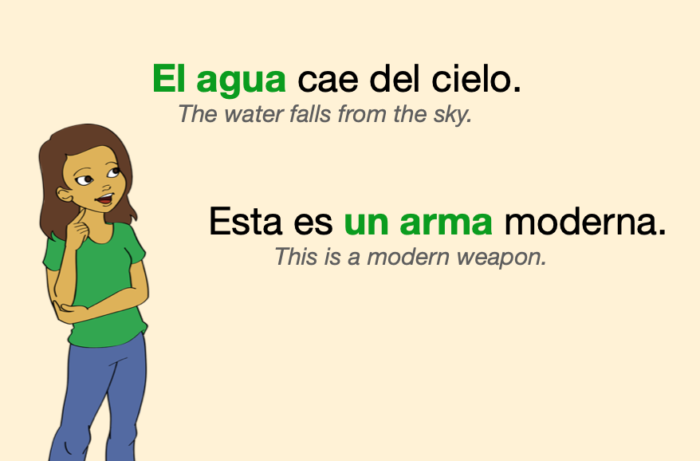There are a few nouns in Spanish that, despite being feminine, are sometimes preceded by the masculine articles el or un.
In this lesson we will learn about these nouns and how to use them properly, reading example sentences.

You will also find an Exercise to practice.
Contents
Which nouns have this property?
We are talking about every feminine noun that has the following characteristics (both of them):
- The feminine noun begins with “a” or “ha”
- That first “a” is the stressed vowel of the noun
Here’s a list of the most frequent feminine nouns with masculine articles:
Spanish English
el agua water
el águila eagle
el ala wing
el alba dawn
el alma soul
el ama de casa housewife
el ancla anchor
el arma weapon
el arpa harp
el asma asthma
el aula classroom
el ave bird
el habla spoken language
el hacha axe
el hambre hunger
When do we use “el” and “un” before these nouns?
As we said, the feminine nouns in this lesson are sometimes preceded by masculine articles el or un.
But for that, the sentence needs to meet the following 2 conditions (both of them):
- The feminine noun has to be in singular form
- There can be no word between article and noun
El agua está fresca.
The water is cool.El águila es grande y poderosa.
The eagle is large and powerful.Esta es un arma muy moderna.
This is a very modern weapon.
If those 2 conditions are not met, we revert to feminine articles
For example, if the feminine noun is plural:
Las hablas de esta región son extrañas.
The spoken languages of this region are strange.Son unas arpas bonitas.
They are beautiful harps.
Or if there are words between article and noun:
Ella bebe la fría agua del río.
She drinks the river’s cold water.El guerrero tiene una gran hacha.
The warrior has a big axe.
Adjectives connected with these nouns are always feminine
Adjectives connected with these nouns are always in feminine form, even in the case where the noun is preceded by el or un.
El águila es muy bonita.
The eagle is very beautiful.Ella tiene un alma sincera
She has a sincere soul.
Also, demonstrative adjectives and possessive adjectives are always feminine before these nouns, never masculine.
For example, it is “esta agua”, not “este agua”.
And it is “nuestra agua”, not “nuestro agua”.
Practice
Exercise
The following sentences include some of the nouns we have studied in this lesson.
Fill the gaps choosing between “el – la – los – las”. Click on the gray spaces to see the solutions:
1) Me gusta el agua de esta fuente.
I like the water of this fountain.
2) Las armas de este ejército son muy modernas.
The weapons of this army are very modern.
3) El arma de ese policía es una pistola.
That cop’s weapon is a pistol.
4) El águila es un animal fascinante.
The eagle is a fascinating animal.
5) La inteligente águila busca una presa.
The clever eagle looks for prey.
6) Las águilas son animales majestuosos.
Eagles are majestic animals.
7) La clara agua de este río inspira a muchos artistas.
The clear water of this river inspires many artists.








